化学专业英语 马永祥 兰州大学--翻译
马永祥《化学专业英语》课文翻译 第14课

化学专业英语马永祥,兰州大学出版社课文翻译14. 含氧化合物醇和酚在醇的取代物和连结体的命名中,羟基作为主要基团,是通过后缀“醇”来表示,省略母体化合物名称末尾“e”(如果有的话),例如:甲醇,2-丙醇,三苯甲醇等。
下面是一些被保留的俗名的例子:烯丙醇,叔丁醇,苄醇,乙二醇,芳香醇等。
苯和其它芳香碳环族的羟基衍生物是通过在碳氢化合物名称加后缀“醇”“二醇”等命名的,“ol”前末端的“e”要省略,例如:1,2,4-苯三醇。
以下是一些芳香族羟基化合物仍被保留的俗名。
例如:苯酚,甲酚,荼酚,邻苯二酚,间苯二酚,对苯二酚等等。
基团RO-是通过在R基名称后加后缀“氧基”而命名,例如:戊氧基,烯丙氧基,苄氧基等,仅有下列含氧基团名称的缩写是不符合这一被推荐规则的:甲氧基,乙氧基,丙氧基,丁氧基,苯氧基,异丙氧基。
除去部分成环体系,二价基团-o-x-o-通过给双二价基团-x-名称附加“二氧基”而命名,例如:乙撑二氧基,丙撑二氧基。
盐醇或酚衍生的阴离子的命名是将醇或酚名称末尾的“-ol”变成“-olate”。
这一方法适用于取代基,官能团和俗名。
例如:甲醇钾,苯酚钠。
醚化合物R1-O-R2总称为“醚”,可以通过取代基或官能团来命名。
不对称醚取代物命名法是将基团R1O-的名称作为前缀加在相应第二个基团R2前面而形成。
较高级的组分被选作母体化合物。
醚的官能团命名法则是在基团R1和R2名称后面加“醚”字即可。
例如:1-异丙氧基丙烷,甲乙醚,二乙醚,乙基乙烯基醚。
醛醛是含有连结在C原子上的(C=O)H基团的化合物,命名是通过后缀“-al”“-aldehyde”或“carbaldehyde”或者是通过加前缀“formyl-”(当作为一个碳链的末端基团存在时代表-(C=O)H),或者与俗名有关,加前缀“oxo”(代表=0),无支链的非环的单醛或二醛的名字是通过给含有相同碳原子数的烃化合物的名字加后缀“-al”(对单醛)或“dial”(对双醛)形成。
化学专业课程中英文对照精校版

化学专业课程中英文对照普通化学General Chemistry分析化学Analytical Chemistry有机化学Organic Chemistry物理化学Physical Chemistry谱学导论Introducton of Spectroscopy无机化学Inorganic Chemistry普通化学和分析化学实验Experiments of General and Analytical Chemistry现在基础化学The Principle of Mordern Chemistry现在基础化学实验Experiments of Modern Fundamental Chemistry有机化学实验Experiments of Organic Chemistry仪器分析和物理化学实验Experiments of Instrumental Analysis and PhysicalChemistry 合成化学实验Experiments of Synthetic Chemistry现代化学专题Topic of Modern Chemistry化学综合实验Experiments of Comprehensive Chemistry化工原理Principle of Chemical Engineering化工原理实验Experiments of Chemical Engineering应用化学实验Experiments of Applied Chemistry无机合成化学Synthetic Inorganic Chemistry近代分析化学Modern Analytical Chemistry分离分析化学Separation Analytical Chemistry有机化合物波谱鉴定Spectrum Identification of Organic Compounds有机合成及反应机理Organic Synthesis and Mechanics化学进展Progress in Chemistry化学反应工程Chemical Reaction Engineering应用电化学Applied Electrochemistry工业催化Industrial Catalysis环境化学Environmental Chemistry环境监测Environmental Monitoring化学科技英语Scientific English for Chemistry数理方法在化学中的应用Mathematical Statistics for Chemistry化工制图Chemical Engineering Cartography计算机与化学测量实验Computer and Chemical Measurement化学信息学Chemoinformatics or Chemical Informatics应用化学专题Special Topics in Applied Chemistry化工装置常用词汇1概论introduction方案(建议书) proposal可行性研究feasibility study方案设计concept design工艺设计process design基础设计basic design详细设计detail design开工会议kick-off meeting审核会议review meeting外商投资foreign investment中外合资joint venture中外合营joint venture补偿贸易compensation trade合同合同附件contract卖方vendor买方buyer顾客client承包商contractor工程公司company供应范围scope of supply生产范围production scope生产能力production capacity项目project界区battery limit装置plant公用工程utilities工艺流程图process flow diagram工艺流程方块图process block diagram管道及仪表流程图piping and instrument drawing 物料及热量平衡图mass & heat balance diagram 蒸汽及冷凝水平衡图steam & condensate balancediagram设备布置图equipment layout设备表equipment list成品(产品) product(final product)副产品by-product原料raw-material设计基础数据basic data for design技术数据technical data数据表data sheet设计文件design document设计规定design regulation现场服务site service项目变更project change用户变更client change消耗定额consumption quota 技术转让technical transfer技术知识technical know-how牋牋牋牋technical knowledge技术保证technical guarantee咨询服务consultative services技术服务technical services工作地点location施工现场construction field报价quotation标书bidding book公司利润company profit固定价合同fixed price contract固定单价合同fixed unit price contract成本加酬金合同cost plus award fee contract定金mobilization银行保证书bank guarantee letter保留金retention所得税income taxes特别承包人税special contractor's taxes城市和市政税city and municipal taxes工作手册work manual工作流程图work flow diagram质量保证程序QA/QC procedures采购计划procurement plan施工计划construction plan施工进度construction schedule项目实施计划project execution plan项目协调程序project coordination procedure 项目总进度计划project master schedule设计网络计划engineering network logic项目质量保证project quality assurance项目质量控制project quality control采购procurement采购周期procurement period会签the squad check计算书calculation sheets询价inquiry检验inspection运输transportation开车start up / commission验收inspection & acceptance校核check审核review审定approve版次version部门department专业specialty项目号project number图号drawing number目录contents序言foreword章chapter节section项item领料单MR material requisition工程规范SPEC engineering specification技术表DATA SHEET technical data sheet技术评标TBA technical bid analysis初期设计包PDP preliminary design package项目经理PM project manager专业负责人LDE lead discipline engineer材料询价单MRQ Material requisition forquotation材料采购单MRP material requisition for purchase 基础工程设计包BEP basic engineering package管道及仪表流程图P&ID piping and instrument drawing(diagram)PFD process flow diagramNNF normally no flowFO failure openFC failure closeC/S/A civil/structure/architectureDDP详细设计阶段detail design phase化工装置词汇二.工艺流程连续过程continuous process间歇过程batch process工艺叙述process description工艺特点process feature操作operation反应reaction副反应side reaction絮凝flocculation浮洗flotation倾析decantation催化反应catalytical reaction萃取extraction中和neutralization水解hydrolysis过滤filtration干燥drying还原reduction氧化oxidation氢化hydrogenation分解decomposition离解dissociation 合成synthetics吸收absorption吸附adsorption解吸desorption结晶crystallization 溶解solution调节modulate控制control悬浮suspension循环circulation再生regeneration再活化reactivation沥取leaching破碎crushing煅烧caloination沉降sedimentation 沉淀precipitation气化gasification冷冻refrigeration固化,结晶solidification包装package升华sublimation燃烧combustion引烧ignition蒸馏distillation碳化carbonization 压缩compression三,化学物质及特性固体solid液体liquid气体gas化合物compound混合物mixture粉powder片状粉末flake小粒granule结晶crystal乳化物emulsion氧化物oxidizing agent 还原剂reducing agent 有机物organic material 真空vacuum母液master liquor富液rich liquor贫液lean liquor萃出物extract萃余物raffinate絮凝剂flocculants冷冻盐水brine酸度acidity浓度concentration碱度alkalinity溶解度solubility凝固点solidificalion point沸点boiling point熔点melting point蒸发率evaporation rate粘度viscosity吸水的water absorbent(a)无水的anhydrous(a)外观appearance无色的colorless(a)透明的transparent(a)半透明的translucent密度density比重specific gravity催化剂catalyst燃烧combustion引燃ignition自然点self-ignition temperature可燃气体combustible gas可燃液体inflammable liquid易燃液体volatile liquid爆炸混合物explosive mixture爆炸性环境explosive atmosphere(environment) 爆炸极限explosive concentration limit 废水waste water废液waste liquid废气off-gas噪声noise pollution成分composition挠度deflection力和力矩force and moment弯矩bending moment应力-应变曲线stress-strain diagram百分比percentage环境温度ambient temperature工作温度operating设计温度design temperature(pressure) 相对湿度RH=relative humidity油渣,淤泥sludge杂质impurity四,化工设备泵pump轴流泵axial flow pump真空泵vacuum pump屏蔽泵canned pump柱塞泵plunger pump 涡轮泵turbine pump涡流泵vortex pump离心泵centrifugal pump喷射泵jet pump转子泵rotary pump管道泵inline pump双作用往复泵double action reciprocating pump计量泵metering pump深井泵deep well pump齿轮泵gear pump手摇泵hand(wobble) pump螺杆泵screw (spiral) pump潜水泵submersible pump斜转子泵inclined rotor pump封闭式电磁泵hermetically sealed magnetic drive pump气升泵air-lift-pump轴承bearing叶轮impeller虹吸管siphon高压容器high pressure vessel焚化炉incinerator火焰清除器flame arrester工业炉furnace烧嘴burner锅炉boiler回转窑rotary kiln加热器heater电加热器electric heater冷却器cooler冷凝器condenser换热器heat exchanger反应器reactor蒸馏釜still搅拌器agitator混合器mixer静态混合器static mixers管道混合器line mixers混合槽mixing tanks破碎机crusher磨碎机grinder研磨机pulverizer球磨机ballmill过滤器filter分离器separator干燥器drier翅片fins烟囱stack火炬flare筛子screen煅烧窑calciner倾析器decanter蒸发器evaporator再沸器reboiler萃取器extractor离心机centrifuger吸附(收)器adsorber结晶器crystallizer电解槽electrolyzer电除尘器electric precipitator洗涤器scrubber消石灰器slaker料仓bin料斗hopper加料器feeder增稠器thickener澄清器clarifier分级器classifier浮洗器flocculator废液池sump喷射器ejector喷头sprayer成套设备package unit仪器设备apparatus附属设备accessory旋转式压缩机rotary compressor往复式压缩机reciprocating compressor 水环式压缩机nash compressor螺杆式压缩机helical screw compressor 离心式压缩机centrifugal compressor多级压缩机mutiple stages compressor 固定床反应器fixed bed reactor流化床反应器fluidized bed reactor管式反应器tubular reactor列管式换热器tubular heat exchanger螺旋板式换热器spiral plate heat exchanger 萃取塔extraction column板式塔plate column填料塔packed column洗涤塔scrubber吸收塔absorber冷却塔cooling tower精馏塔fractionating tower汽提塔stripper再生塔regenerator造粒塔prill tower塔附件tower accessories 液体分配(布)器liquid distributor填料支持板support plate定距管spacer降液管downcomer升气管chimney顶(底)层塔盘top (bottom) tray挡板baffle抽出口draw nozzle溢流堰weir泡罩bubble cap筛板sieve plate浮阀float valve除沫器demister pad塔裙座skirt椭圆封头elliptical head高位槽head tank中间槽intermediate tank加料槽feed tank补给槽make-up tank计量槽measuring tank电解槽cell溜槽chute收集槽collecting tank液滴分离器knockout drum稀释罐thinning tank缓冲罐surge drum回流罐reflux drum闪蒸罐flash drum浮顶罐floating roof tank内浮顶罐covered floating roof tank 球罐spheroid气柜gas holder湿式气柜wet gas-holder干式气柜dry gas-holder螺旋式气柜helical gas-holder星型放料器,旋转阀rotary valve抽滤器mutche filter压滤器filter press压滤机pressure filter板框压滤器plate-and-fram filter press 转鼓过滤器rotary drum filter带式过滤器belt filter翻盘式过滤器袋滤器bag filter旋风分离器cyclone separator盘式干燥箱compartment tray drier真空干燥器vacuum drier隧道式干燥器tunnel drier回转干燥器rotary drier穿流循环干燥器through circulation drier喷雾干燥器spray drier气流干燥器pneumatic conveyor drier圆盘式加料器dish feeder螺旋式加料器screw feeder颚式破碎机jaw crusher回转破碎机gyratory crusher滚洞破碎机roll crusher锤式破碎机hammer crusher冲击破碎机rotor impact breaker气流喷射粉碎机jet pulverizer棍磨机rod mill雷蒙机raymond mill锤磨机hammer mill辊磨机roller mill振动筛vibrating screen回转筛rotary screen风机fan罗茨鼓风机root's blower起重机crane桥式起重机bridge crane电动葫芦motor hoist发电机generator电动机motor汽轮机steam turbine五,管道工程piping engineering阀门valve阀杆stem内螺纹阀杆inside screw阀座valve seat (body seat)阀座环,密封圈sealing ring阀芯(包括密封圈,杆等)trim阀盘disc阀体body阀盖bonnet手轮hand wheel手柄hand level (handle)压盖gland闸阀gate valve平行双闸板double disc parallel seat楔形单闸板split wedge截止阀globe valve节流阀throttle valve针阀needle valve角阀(角式截止阀) angle valve Y型阀(截止阀) Y-valve(Y-body globe valve) 球阀ball valve三通球阀3-way ball valve蝶阀butterfly valve 对夹式(薄片型) wafer type偏心阀板蝶阀offset disc (eccentric) butterfly valve斜阀盘蝶阀canted disc butterfly valve连杆式蝶阀link butterfly valve止回式蝶阀combined non-return butterfly valve柱塞阀piston type valve旋塞阀plug valve三通旋塞阀three-way plug valve四通旋塞阀four-way plug valve旋塞cock衬套旋塞sleeve cock隔膜阀diaphragm valve橡胶衬里隔膜阀rubber lined diaphragm valve 直通式隔膜阀straight way diaphragm valve 夹紧式胶管阀pinch valve止回阀check valve升降式止回阀lift check valve旋启式止回阀swing check valve落球式止回阀ball check valve弹簧球式止回阀spring ball check valve底阀foot valve切断式止回阀stop check valve活塞式止回阀piston check valve翻板止回阀flap check valve蝶式止回阀butterfly check valve安全泄气阀safety[SV]安全泄放阀relief valve[RV]安全泄压阀safety relief valve杠杆重锤式lever and weight type罐底排污阀flush-bottom tank valve波纹管密封阀bellow sealed valve电磁阀solenoid (operated) valve电动阀electrically(electric-motor)operated valve气动阀pneumatic operated valve低温用阀cryogenic service valve蒸汽疏水阀steam trap机械式疏水阀mechanical trap浮桶式疏水阀open (top) bucket trap浮球式疏水阀float trap倒吊桶式疏水阀inverted bucket trap自由浮球式疏水阀loose float trap恒温式疏水阀thermostatic trap压力平衡式恒温疏水阀balanced pressure thermostatic trap热动力式疏水阀thermodynamic trap脉冲式蒸汽疏水阀impulse steam trap放汽阀(自动放汽阀) (automatic) air vent valve换向阀diverting (reversing) valve呼吸阀breather valve减压阀pressure reducing valve控制阀control valve执行机构actuator差压调节阀differential pressure regulating valve切断阀block (shut-off, stop) valve调节阀regulating valve快开阀quick opening valve快闭阀quick closing valve隔断阀isolating valve三通阀three way valve夹套阀jacketed valve非旋转式阀non-rotary valve2管子,管件,法兰管子pipe(按标准制造的配管用管) tube(不按标准规格制造的其它用管)钢管steel pipe铸铁管cast iron pipe衬里管lined pipe复合管clad pipe碳钢管carbon steel[C.S.]pipe合金钢管alloy steel pipe不锈钢管stainless steel[S.S.]pipe奥氏体不锈钢管austenitic stainless steel pipe铁合金钢管ferritic alloy steel pipe轧制钢管wrought-steel pipe锻铁管wrought-iron pipe无缝钢管seamless[SMLS] steel pipe焊接钢管welded steel pipe电阻焊钢管electric-resistance-welded steel pipe电熔(弧)焊钢板卷管electric-fusion(arc)-welded steel-plate pipe螺旋焊接钢管spiral welded steel pipe镀锌钢管galvanized steel pipe排污阀blowdown valve集液排放阀drip valve排液阀drain valve放空阀vent valve卸载阀unloading valve排出阀discharge valve吸入阀suction valve取样阀sampling valve手动阀hand operated(manually-operated) valve(水)龙头bibb;bib;faucet 抽出液阀(小阀) bleed valve旁路阀by-pass valve软管阀hose valve混合阀mixing valve破真空阀vacuum breaker冲洗阀flush valve根部阀root (primary, header) valve 水煤气钢管water-gas steel pipe塑料管plastic pipe玻璃管glass tube橡胶管rubber tube壁厚wall thickness[WT]壁厚系列号schedule number[SCH.NO.] 加厚的,加强的extra heavy (strong)双倍加厚的,双倍加强的double extra heavy (strong) 弯头elbow异径弯头reducing elbow长半径弯头long radius elbow短半径弯头short radius elbow长半径180°弯头long radius return短半径180°弯头short radius return三通tee异径三通reducing tee等径三通straight tee带支座三通base tee 45°斜三通45°lateralY 型三通true"Y"四通cross异径管reducer同心异径管concentric reducer偏心异径管eccentric reducer管接头coupling;full coupling活接头union短管nipple预制弯管fabricated pipe bendU型弯管"U"bend法兰端flanged end万向接头universal joint对焊的butt welded[BW]螺纹的threaded[THD]承插焊的socket welded[SW]法兰flange[FLG]整体管法兰integral pipe flange钢管法兰steel pipe flange螺纹法兰threaded flange滑套法兰slip-on flange平焊法兰slip-on-welding flange承插焊法兰socket welding flange松套法兰lap joint flange[LJF]对焊法兰weld neck flange[WNF]法兰盖blind flange;blind异径法兰reducing flange压力级pressure rating(class)突面raised face[RF]凸面male face凹面female face全平面;满平面flat face;full face[FF]3.管道特殊件piping speciality粗滤器strainer过滤器filter临时过滤器temporary strainer(cone type) Y 型过滤器Y-type strainerT 型过滤器T-type strainer永久过滤器permanent filter洗眼器及淋浴器eye washer and shower视镜sight glass阻火器flame arrester喷咀;喷头spray nozzle喷射器ejector取样冷却器sample cooler消音器silencer膨胀节expansion joint波纹膨胀节bellow补偿器compensator软管接头hose connection[HC]快速接头quick coupling金属软管metal hose橡胶管rubber hose挠性管flexible tube特殊法兰special flange漏斗funnel8 字盲板spectacle (figure 8) blind爆破板rupture disk4,其它材料碳素钢carbon steel [C.S.]不锈钢stainless steel[S.S.]铸铁cast iron[C.I.]铝aluminum铜,紫铜copper钛titanium抗拉强度tensile strength非金属材料non-metallic material塑料plastic陶瓷ceramic搪瓷porcelain enamel玻璃glass橡胶rubber垫片gasket[GSKT] 平垫片flat gasket填料packing型钢shaped steel角钢angle steel槽钢channel工字钢I-beam宽缘工字钢或H 钢wide flanged beam扁钢flat bar圆钢round steel; rod钢带strap steel网络钢板checkered plate材料表bill of material[BOM]材料统计material take-off[MTO]散装材料bulk material综合管道材料表consolidated piping material summary sheet[CPMSS]汇总表summary sheet5.设备布置及管道设计中心线center line装置边界boundary limit[BL]区界area limit设备布置equipment arrangement (layout);plot plan标高,立面elevation[EL]支撑点point of support[POS]工厂北向plant north方位orientation危险区hazardous area classification净正吸入压头net positive suction head绝对标高absolute elevation坐标coordinate管道研究piping study管道布置平面piping arrangement plan[PAP] 管道布置piping assembly; layout详图detail"X"视图view "X""A-A" 剖视section "A-A"轴测图isometric drawing索引图key plan管道及仪表流程图piping and instrumentdiagram[P&ID]管口表list of nozzles地上管道above ground piping地下管道under ground piping管线号line number总管header; manifold旁路by pass常开normally open常闭normally closed取样接口sampling connection 伴热管tracing pipe蒸汽伴热steam tracing热水伴热hot-water tracing电伴热electrical tracing夹套管jacketed line全夹套管full jacketed比例scale图figure草图sketch图例legend符号symbol件号part no。
兰大化学专业英语-精选

3
P-block Element
IIIA B Boron Al Aluminium Ga Gallium In Indium Tl Thallium
IV A C Carbon Si Silicon Ge Germanium Sn Tin Pb Lead
VA N Nitrogen P Phosphorus As Arsenic Sb Antimony Bi Bismuth
举例: PH3: phosphine或phosphane SbH3: stibine或stibane CH4: methane B2H6: diborane
AsH3: arsine或arsane BiH3: bismuthane SiH4: silane
17
无氧酸
命名规则:hydro-词根-ic acid 举例: HCl: hydrochloric acid H2S : hydrosulfuric acid
6
Naming metal ions (cations) for metal oxides, bases and salts
1. Single valence ions
Cation’s name = Element
for example: Na+ Sodium K+ Potassium
Al3+ Aluminum Ca2+ Calcium
for example:
FeO oxide)
Fe2O3 Fe3O4 Pb3O4 Na2O2
Iron(II) oxide (Ferrous
Iron(III) oxide (Ferric oxide) Ferroferric oxide Trilead tetroxide Sodium peroxide
专业外语(化学容器)
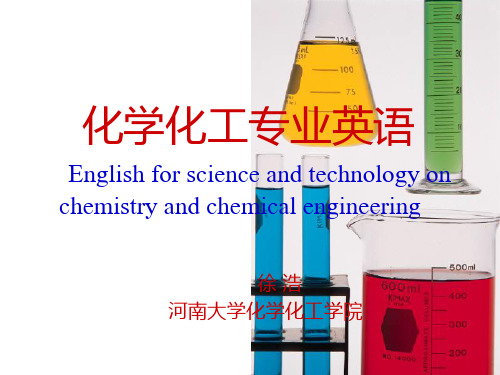
3 ) Anions containing hydrogen ( 含 氢 阴 离 子 ) : hydrogen or dihydrogen + 去掉氢的离子名称
例:HCO3-:hydrogen carbonate ion H2PO4-: dihydrogen phosphate ion
3. Names of ionic compounds(离子化 合物的命名):
烃类名称前 + cyclo-
例: 环己烷: cyclohexane; 环己二烯: cyclohexadiene
5.醇、酚(Alcohol,Phenol)的命 名
* 醇、酚:在相应的烃的名称后,去“-e”加“ol”。如果是二醇或三醇,则须加“diol”或“-triol” 。
CH3 CH3COH
CH3
• 例:CO2:carbon dioxide;
•
CO:carbon monoxide
•
P2O5:diphosphorus pentoxide;
•
SF6:sulfur hexafluoride;
5. Names of Acids(酸的命名)
以ide为词尾的阴离子形成的酸: hydro+元素名称的词干+ic acid
SO42-:sulfate ion(S:sulfur); SO32-:sulfite ion;
NO3-:nitrate ion(N:nitrogen);NO2-:nitrite ion ;
* 如果某元素能形成一种以上的含氧阴离 子,则按以下规则:
a. 高(过)* 酸根离子:per- + 非氧元素 名称的词干 + -ate + ion
3.炔烃(alkyne )命名
化学化工专业英语(1)

2021/7/8
22
1.4 科技英语翻译标准
科技英语的翻译标准有三条:信,达,专 业术语正确。要求译者必须准确理解和掌 握原著的内容,决不能主管发挥译者个人 的想法和推测。译者在确切理解原著的基 础上,又必须很好地运用本语言把原文通 顺、流畅地表达出来。
2021/7/8
23
例如:
The moment the circuit is completed, a current will start flowing toward the coil.
6
1.1 科技英语的概念
科技英语是一种用英语阐述科学技术 中的理论、技术、实验和现象等的英 语语言体系,它在词汇、语法和文体 诸多方面都有自己的特点,因而自成 一门专门的学科。
2021/7/8
7
1.2 科技英语的产生与发展
科技英语(English for Science and Technology,简称EST),诞生于20世纪50 年代,是第二次世界大战后科学技术迅猛 发展的产物。70年代以来,科技英语在国 际上引起了广泛的注意和研究。目前已经 发展成为一种重要的英语文体。
2021/7/8
30
(二)汉语表达阶段
表达就是选择恰当的汉语,把已经理解了的原作 内容叙述出来。在翻译的表达阶段,要特别注意 的是,翻译表达和创作表达是不一样的,译者要 表达的是原文作者已经表达出来的东西,因此必 须按照原著作者的思维逻辑表达。虽然提倡在深 刻理解的基础上创造性地表达,但译者不能任意 发挥,随意删改。一般说来,在翻译表达方面译 者要注意以下几个问题:
2021/7/8
26
大致说来,理解阶段包括一下几个方面:
1.领略全文大意
通读一遍,不同的词,词组甚至是句子在不 同的语境中可能有不同的意思。任何一篇文章或 一段文字都是一个有机整体,词与词,词与句子, 句子与段落甚至整个篇章之间,都有着必然的内 在联系。这就要求译者在动手翻译之前,务必通 读全文,领略大意,切忌一开始就把注意力集中 在一词一词的推敲上,看一句译一句。
马永祥版化学专业英语第2-17-33课翻译
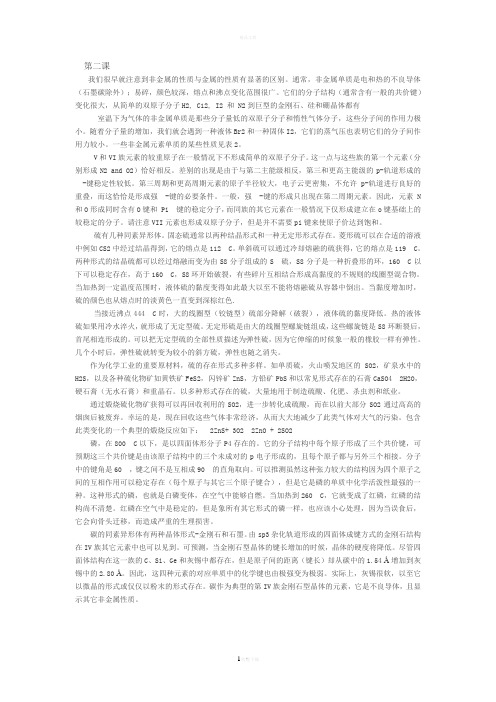
第二课我们很早就注意到非金属的性质与金属的性质有显著的区别。
通常,非金属单质是电和热的不良导体(石墨碳除外);易碎,颜色较深,熔点和沸点变化范围很广。
它们的分子结构(通常含有一般的共价键)变化很大,从简单的双原子分子H2, C12, I2 和 N2到巨型的金刚石、硅和硼晶体都有室温下为气体的非金属单质是那些分子量低的双原子分子和惰性气体分子,这些分子间的作用力极小。
随着分子量的增加,我们就会遇到一种液体Br2和一种固体I2,它们的蒸气压也表明它们的分子间作用力较小。
一些非金属元素单质的某些性质见表2。
V和VI族元素的较重原子在一般情况下不形成简单的双原子分子。
这一点与这些族的第一个元素(分别形成N2 and O2)恰好相反。
差别的出现是由于与第二主能级相反,第三和更高主能级的p-轨道形成的-键稳定性较低。
第三周期和更高周期元素的原子半径较大,电子云更密集,不允许p-轨道进行良好的重叠,而这恰恰是形成强-键的必要条件。
一般,强-键的形成只出现在第二周期元素。
因此,元素N 和O形成同时含有O键和 Pi 键的稳定分子,而同族的其它元素在一般情况下仅形成建立在o键基础上的较稳定的分子。
请注意VII元素也形成双原子分子,但是并不需要pi键来使原子价达到饱和。
硫有几种同素异形体。
固态硫通常以两种结晶形式和一种无定形形式存在。
菱形硫可以在合适的溶液中例如CS2中经过结晶得到,它的熔点是112C。
单斜硫可以通过冷却熔融的硫获得,它的熔点是119C。
两种形式的结晶硫都可以经过熔融而变为由S8分子组成的S硫,S8分子是一种折叠形的环,160C以下可以稳定存在,高于160C,S8环开始破裂,有些碎片互相结合形成高黏度的不规则的线圈型混合物。
当加热到一定温度范围时,液体硫的黏度变得如此最大以至不能将熔融硫从容器中倒出。
当黏度增加时,硫的颜色也从熔点时的淡黄色一直变到深棕红色.当接近沸点444C时,大的线圈型(铰链型)硫部分降解(破裂),液体硫的黏度降低。
化学化工专业英语(1)
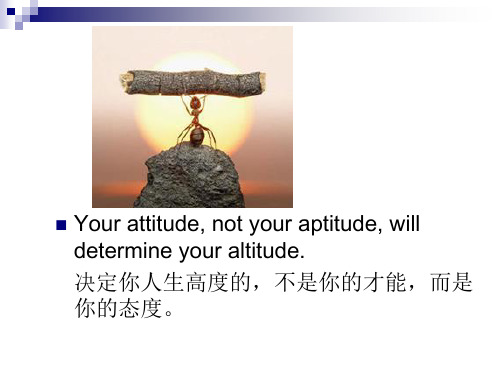
例如:
The operation of a machine needs some knowledge of its performance. 操作机器需要懂得机器的一些性能。 (n.→v.) The continuous process can ordinarily be handled in the less space. 连续过程通常能节省操作空间。 (adj.→v.)
Syllabus?(课程纲领)
本书共分为三部分: 第一部分为“科技英语翻译方法”; 第二部分为“专业文章阅读与翻译”; 第三部分为“科技论Exam (1): close-book exam, covering all nomenclature, dictionary NOT allowed Exam (2): open-book, comprehensive, dictionary allowed
科技著作、科技论文及报告、实验报告及方 案; 各类科技情报及文字资料; 科技实用手册的结构描述和操作规程; 有关科技问题的会谈、会议; 有关科技的影片、录像及光盘等有声资料的 解说词等。
科技英语要求其客观性、准确性及 严密性,注意叙事逻辑上的连贯及表 达上的明晰、畅达,避免行文晦涩。 科技英语力求平易和精确,避免使用 旨在加强语言感染力和宣传效果的各 种修饰词,以免使读者产生行文浮华, 内容虚饰之感。
2.被动语态多
1.据语言学家统计,物理、化学、工程类的教科书里, 约有1/3的动词用于被动语态句。 2. 这是因为科技人员最最关心的是行为、活动、事实 本身,至于谁做的,无关紧要,而且运用被动语态显 得文章所描述的内容更客观,可减少一些主观印象。 例如: Mathematics is used in many different fields. people use mathematics in many different fields.
化学与化工专业英语2-化学基础知识

Part 3 Chemical Calculation(化学计算 )
3.1 化 学 术 语
atomic mass/weight ; molecular weight amount (of substance); mole number of moles ; molar mass molar volume ; concentration molarity ; excess agent limiting agent ; reactant product ; yield
91
镤
Radium*
Ra
88
镭
Radon*
Rn
86
氡
Rhenium*
Re
75
铼
Rhodium*
4
铍
Bismuth*
Bi
83
铋
Boron*
B
5
硼
Bromine*
Br
35
溴
Cadmium*
Cd
48
镉
Calcium*
Ca
20
钙
Californium
Cf
98
锎
Carbon*
C
6
碳
Cerium
Ce
58
铈
Cesium*
Cs
55
铯
化 学 方 程 式
Part 2 Chemical Equations
2、反应条件
催化剂
04
高温、高压
03
3.1 Nitrogen reacts with hydrogen to form ammonia at high temperature and pressure with the presence of a catalyst.
《科技英语》课程教学大纲-

《科技英语》课程教学大纲-(Chemistry English)一、课程基本信息课程编号:10084045课程类别:专业选修课适用专业:化学、化教、应用化学、高分子材料与工程、化学工程与工艺、制药工程学分:2总学时:32 其中理论学时:32, 实验学时:0先修课程:英语、有机化学、无机化学、分析化学、物理化学后续课程:文献检索、毕业论文选用教材:马永祥、吴隆民、梁永民等编,《化学专业英语》,兰州大学出版社,2008年第三版必读书目:(不少于5本)刘宇红编,《化学化工专业英语》,中国轻工业出版社,2006。
孙乃有、曹克广编,《化学化工专业英语》,高等教育出版社,2006。
尹德胜、叶蔚君编,《化学化工专业英语》,化学工业出版社,2008。
魏高原编,《化学专业基础英语》,北京大学出版社,2000年。
符德学编,《化学化工专业英语》,化学工业出版社,2003。
选读书目(五号、黑体、顶格):(不少于5本)Organic Chemistry(第四版)[M].Francis A. Carey编著;McGraw-Hill Higher Education 2 000出版。
董坚主编,《化学化工专业英语》,浙江大学出版社,2002。
杨定乔、龙玉华、王升富编,《化学化工专业英语》,化学工业出版社,2008。
二、课程教学目标在科技英语词汇中,涉及化学和化工领域的词汇数量巨大。
本课程主要教授化学化工专业英语。
讲授化学化工文献中的常用术语,常用化学化工词头、词尾、缩写词和各种有机化合物词汇的构成和书写,化学方程式的英文描述方式与技巧;讲授各类化合物各基团之间的构成、派生和相互关系、化学科技论文和文献的翻译技巧等。
1、通过本课程学习,使学生掌握好专业英语的语法特点,逐步培养学生具有比较熟练的阅读理解能力,专业英语翻译能力和熟悉专业词汇,可以过渡到较顺利地阅读专业文献资料的能力。
(支撑毕业要求3,4,5)2、使学生能以英语为工具,获取本专业所需信息。
化学专业英语,中英互译,考前必备

1.有机化学Inorganic chemistry 无机化学organic chemistry物理化学physical chemistry 分析化学Analytical chemistry 生物化学biochemistry 化工原理principles of chemical engineering热力学thermodynamics2.烷烃Alkanes烯烃Alkenes 炔烃Alkynes 甲烷Methane乙烯Ethene 乙炔Ethyne环己烷Cyclohexane苯Naphthalene 醇Alcohols醚Ethers 酮Ketones醛Aldehydes酯Esters羧酸Fatty Acids胺Amines 氰Cyanides碳水化合物Carbohydrates氨基酸Amino Acides 蛋白质protein 脂质lipids3. 氨基甲酸酯carbamate沉淀precipitation测定determine 除草剂herbicide 单元操作Unit operations底物substrate 定性分析qualitative 定量分析gravimetric发色团chromophore 分离isolate 分析物analyte 反应速率Reaction rate 过滤filtration化学污染chemical pollution合成synthesize解吸附作用desorption基本原理fundamental principle科学领域scientific fields农药pesticide亲核试剂nucleophile 杀菌剂fungicide 石化产品Petrochemical 碳氢化合物Hydrocarbons 碳阳离子carbocation物性the properties of substance 新陈代谢metabolism吸附adsorption有毒化学品toxic chemical 有机氯化物Organic chloride自然变化natural changes准确度accuracy 助色团auxochrome 植物生长调节剂plant growth regulator蒸馏distillation4.烧杯beakers通风橱Furne hoods 锥形瓶Erlenmeyer圆底烧瓶Round bottom flask蒸馏烧瓶Distillation蒸发皿Evaporating dishes真空干燥器Vaccume dessicator5.Al2O3aluminium(III) oxide BaCl2 Barium(II) chloride BaI2 Barium iodide Ca(MnO4)2Calcium permanganate Cu2S copper(I) sulphide CuO Copper(II) oxide FeSO4 Iron(II) sulfate HClO4 perchloric acid H2SO4 sulphuric acid H2CO3Carbouic acide HPO4diammonium hydrogen phosphate KHSO4 potassium hydrogen sulphide KMnO4 Potassium permanganate (NH4)2CO3ammoniue carbonate (NH4)2SO4 Ammmonium sulfate N2O nitrogen(I) oxide NaH Sodium permanganate P4O6 tetraphosphorus hexaoxide PF5phosphorus pentafluoride P4O10 tetraphosphorus decaoxide Sncl4 tin(IV) chloride6.There are 20 standard amino acids , and they contain a carboxyl group ,an amino group ,and a side chain . 有20个标准氨基酸,和含有羧基、一个氨基和侧链。
化学专业英语马永祥翻译36课
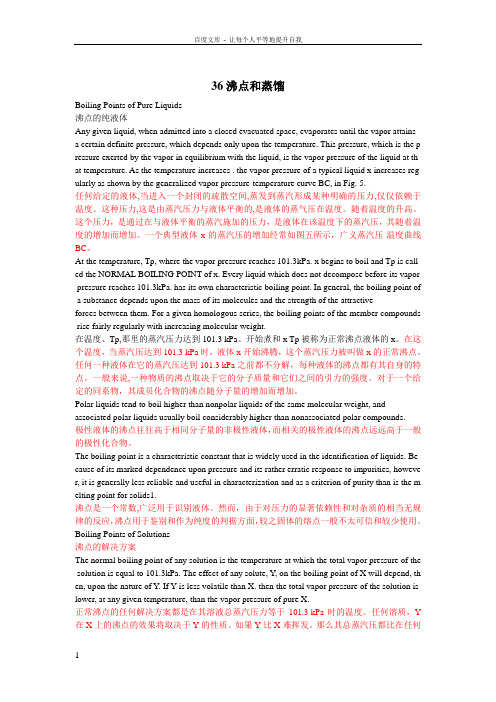
36 沸点和蒸馏Boiling Points of Pure Liquids沸点的纯液体Any given liquid, when admitted into a closed evacuated space, evaporates until the vapor attains a certain definite pressure, which depends only upon the temperature. This pressure, which is the p ressure exerted by the vapor in equilibrium with the liquid, is the vapor pressure of the liquid at th at temperature. As the temperature increases . the vapor pressure of a typical liquid x increases reg ularly as shown by the generalized vapor pressure-temperature curve BC, in Fig. 5.任何给定的液体,当进入一个封闭的疏散空间,蒸发到蒸汽形成某种明确的压力,仅仅依赖于温度。
这种压力,这是由蒸汽压力与液体平衡的,是液体的蒸气压在温度。
随着温度的升高。
这个压力,是通过在与液体平衡的蒸汽施加的压力,是液体在该温度下的蒸汽压,其随着温度的增加而增加。
一个典型液体x的蒸汽压的增加经常如图五所示,广义蒸汽压-温度曲线BC。
At the temperature, Tp, where the vapor pressure reaches 101.3kPa. x begins to boil and Tp is call ed the NORMAL BOILING POINT of x. Every liquid which does not decompose before its vapor pressure reaches 101.3kPa. has its own characteristic boiling point. In general, the boiling point of a substance depends upon the mass of its molecules and the strength of the attractiveforces between them. For a given homologous series, the boiling points of the member compounds rise fairly regularly with increasing molecular weight.在温度、Tp,那里的蒸汽压力达到101.3 kPa。
化学专业英语翻译(修订版)17有机化学氧化还原
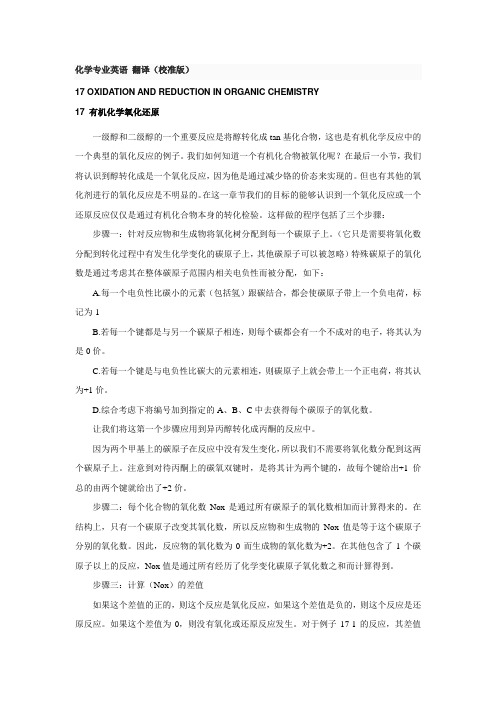
化学专业英语翻译(校准版)17 OXIDA TION AND REDUCTION IN ORGANIC CHEMISTRY17 有机化学氧化还原一级醇和二级醇的一个重要反应是将醇转化成tan基化合物,这也是有机化学反应中的一个典型的氧化反应的例子。
我们如何知道一个有机化合物被氧化呢?在最后一小节,我们将认识到醇转化成是一个氧化反应,因为他是通过减少铬的价态来实现的。
但也有其他的氧化剂进行的氧化反应是不明显的。
在这一章节我们的目标的能够认识到一个氧化反应或一个还原反应仅仅是通过有机化合物本身的转化检验。
这样做的程序包括了三个步骤:步骤一:针对反应物和生成物将氧化树分配到每一个碳原子上。
(它只是需要将氧化数分配到转化过程中有发生化学变化的碳原子上,其他碳原子可以被忽略)特殊碳原子的氧化数是通过考虑其在整体碳原子范围内相关电负性而被分配,如下:A.每一个电负性比碳小的元素(包括氢)跟碳结合,都会使碳原子带上一个负电荷,标记为-1B.若每一个键都是与另一个碳原子相连,则每个碳都会有一个不成对的电子,将其认为是0价。
C.若每一个键是与电负性比碳大的元素相连,则碳原子上就会带上一个正电荷,将其认为+1价。
D.综合考虑下将编号加到指定的A、B、C中去获得每个碳原子的氧化数。
让我们将这第一个步骤应用到异丙醇转化成丙酮的反应中。
因为两个甲基上的碳原子在反应中没有发生变化,所以我们不需要将氧化数分配到这两个碳原子上。
注意到对待丙酮上的碳氧双键时,是将其计为两个键的,故每个键给出+1价总的由两个键就给出了+2价。
步骤二:每个化合物的氧化数Nox是通过所有碳原子的氧化数相加而计算得来的。
在结构上,只有一个碳原子改变其氧化数,所以反应物和生成物的Nox值是等于这个碳原子分别的氧化数。
因此,反应物的氧化数为0而生成物的氧化数为+2。
在其他包含了1个碳原子以上的反应,Nox值是通过所有经历了化学变化碳原子氧化数之和而计算得到。
药学专业英语

3. 专业英语词汇具体特点:
(1) 广泛使用表示动作或状态的抽象名词,以及有 名词功用的动名词
(2) 广泛采用名词连用形式 (3) 复合词 (4) 缩略词
(1) 广泛使用表示动作或状态的Fra bibliotek象名词,动名词
the standardization of the product absorption rate constant limit date of using a drug after its production therapeutic drug monitoring random screening in drug discovery (in-plane) bending vibration
Pharmaceutical Engineering 34课时
学时分配 3课时
7课时 6课时 9课时 6课时 3课时
参考书目 (reference books)
[1]唐冬雁,刘本才主编.《应用化学专业英语》,哈尔滨工业大学 出版社,2019。 [2]魏高原编.《化学专业基础英语》,北京大学出版社,2019。 [3]胡宏纹编.《有机化学》,高等教育出版社,1990。 [4]马永祥,吴隆民,梁永民等编.《化学专业英语》,兰州大学出 版社,2019
"听说有个很好的工作要你去干。" "挺好的工作"。 "打算干吗?" "不。" "为什么不干?" "不想干"。 摘自《刀锋》(the Razor's Edge )
《Gone with wind》:
Home! I‘ll go home, and I‘ll think of some way to get him back. After all, tomorrow is another day. 《Titanic》:
化学专业英语(马永祥版)第一课的英文翻译
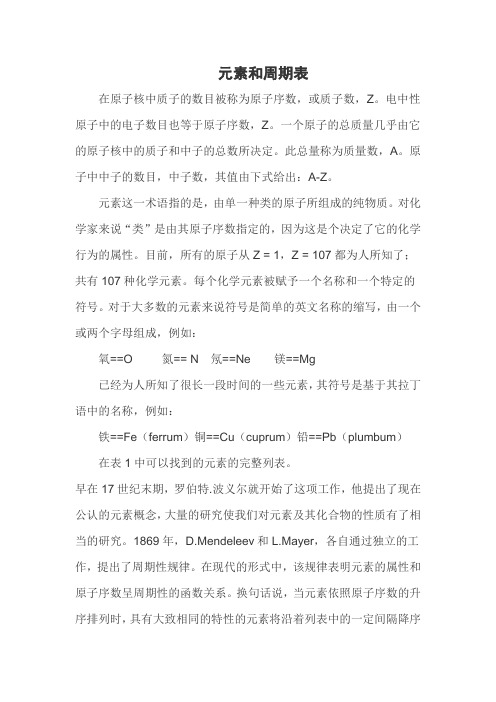
元素和周期表在原子核中质子的数目被称为原子序数,或质子数,Z。
电中性原子中的电子数目也等于原子序数,Z。
一个原子的总质量几乎由它的原子核中的质子和中子的总数所决定。
此总量称为质量数,A。
原子中中子的数目,中子数,其值由下式给出:A-Z。
元素这一术语指的是,由单一种类的原子所组成的纯物质。
对化学家来说“类”是由其原子序数指定的,因为这是个决定了它的化学行为的属性。
目前,所有的原子从Z = 1,Z = 107都为人所知了;共有107种化学元素。
每个化学元素被赋予一个名称和一个特定的符号。
对于大多数的元素来说符号是简单的英文名称的缩写,由一个或两个字母组成,例如:氧==O 氮== N氖==Ne镁==Mg已经为人所知了很长一段时间的一些元素,其符号是基于其拉丁语中的名称,例如:铁==Fe(ferrum)铜==Cu(cuprum)铅==Pb(plumbum)在表1中可以找到的元素的完整列表。
早在17世纪末期,罗伯特.波义尔就开始了这项工作,他提出了现在公认的元素概念,大量的研究使我们对元素及其化合物的性质有了相当的研究。
1869年,D.Mendeleev和L.Mayer,各自通过独立的工作,提出了周期性规律。
在现代的形式中,该规律表明元素的属性和原子序数呈周期性的函数关系。
换句话说,当元素依照原子序数的升序排列时,具有大致相同的特性的元素将沿着列表中的一定间隔降序排列。
因此,将具有类似性质的元素排成纵列,从而将元素排成表格的形式是可能的。
这种安排被称为一个周期表。
每个一行中的元素构成一个周期。
应当指出的是周期表的长度是变化的。
有一个很短的周期只由2个元素组成,随后的两个周期各有8个元素,接下来的两个长周期各有18个元素。
再接下来的一个周期包括32个元素,最后一个周期显然是不完整的。
这样的安排,使得相同的垂直列中的元素具有类似的特性。
这些列构成的化学族或群。
那些以两个八元素周期为首的族中的元素被指定为主族元素,和其他各组的成员被称为过渡或内过渡元素。
化学专业英语-马永祥-兰州大学

ContentsTHE ELEMENTS AND THE PERIODIC TABLE01. ......................................................- 3 -THE NONMETAL ELEMENTS02. ..................................................................................- 5 -GROUPS IB AND IIB ELEMENTS03. ............................................................................- 7 -GROUPS IIIB—VIIIB ELEMENTS04. ............................................................................- 9 -INTERHALOGEN AND NOBLE GAS COMPOUNDS05. ...........................................- 11 -06. ....................................- 13 -THE CLASSIFICATION OF INORGANIC COMPOUNDSTHE NOMENCLATURE OF INORGANIC COMPOUNDS07. ....................................- 15 -BRONSTED'S AND LEWIS' ACID-BASE CONCEPTS08. ..........................................- 19 -09. ..........................................................................- 22 -THE COORDINATION COMPLEXALKANES10. ..................................................................................................................- 25 -11. .............................................................................- 28 -UNSATURATED COMPOUNDSTHE NOMENCLATURE OF CYCLIC HYDROCARBONS12. ...................................- 30 -SUBSTITUTIVE NOMENCLATURE13. .......................................................................- 33 -14. .......................................................- 37 -THE COMPOUNDS CONTAINING OXYGENPREPARATION OF A CARBOXYLiC ACID BY THE GRIGNARD METHOD15. ..- 39 -THE STRUCTURES OF COVALENT COMPOUNDS16. ............................................- 41 -OXIDATION AND REDUCTION IN ORGANIC CHEMISTRY17. ............................- 44 -SYNTHESIS OF ALCOHOLS AND DESIGN OF ORGANIC SYNTHESIS18. ..........- 47 -ORGANOMETALLICS—METAL π COMPLEXES19. ................................................- 49 -THE ROLE OF PROTECTIVE GROUPS IN ORGANIC SYNTHESIS20. ...................- 52 -ELECTROPHILIC REACTIONS OF AROMATIC COMPOUNDS21. ........................- 54 -POLYMERS22. ................................................................................................................- 57 -ANALYTICAL CHEMISTRY AND PROBLEMS IN SOCIETY23. ............................- 61 -VOLUMETRIC ANALYSIS24. ......................................................................................- 63 -QUALITATIVE ORGANIC ANALYSIS25. ..................................................................- 65 -VAPOR-PHASE CHROMATOGRAPHY26. .................................................................- 67 -INFRARED SPECTROSCOPY27. ..................................................................................- 70 -NUCLEAR MAGNETIC RESONANCE (I)28. ..............................................................- 72 -NUCLEAR MAGNETIC RESONANCE(II)29. ..............................................................- 75 -A MAP OF PHYSICAL CHEMISTRY30. ......................................................................- 77 -THE CHEMICAL THERMODYNAMICS31. ................................................................- 79 -CHEMICAL EQUILIBRIUM AND KINETICS32. ........................................................- 82 -THE RATES OF CHEMICAL REACTIONS33. ............................................................- 85 -NATURE OF THE COLLOIDAL STATE34. .................................................................- 88 -ELECTROCHEMICAL CELLS35. .................................................................................- 90 -BOILING POINTS AND DISTILLATION36. ...............................................................- 93 -EXTRACTIVE AND AZEOTROPIC DISTILLATION37. ............................................- 96 -CRYSTALLIZATION38. ................................................................................................- 98 -39. ...................................................................................- 100 -MATERIAL ACCOUNTINGTHE LITERATURE MATRIX OF CHEMISTRY40. ...................................................- 102 -01. THE ELEMENTS AND THE PERIODIC TABLEThe number of protons in the nucleus of an atom is referred to as the atomic number, or proton number, Z. The number of electrons in an electrically neutral atom is also equal to the atomic number, Z. The total mass of an atom is determined very nearly by the total number of protons and neutrons in its nucleus. This total is called the mass number, A. The number of neutrons in an atom, the neutron number, is given by the quantity A-Z.The term element refers to, a pure substance with atoms all of a single kind. To the chemist the "kind" of atom is specified by its atomic number, since this is the property that determines its chemical behavior. At present all the atoms from Z = 1 to Z = 107 are known; there are 107 chemical elements. Each chemical element has been given a name and a distinctive symbol. For most elements the symbol is simply the abbreviated form of the English name consisting of one or two letters, for example:oxygen==O nitrogen ==N neon==Ne magnesium ==MgSome elements,which have been known for a long time,have symbols based on their Latin names, for example: iron==Fe(ferrum) copper==Cu(cuprum) lead==Pb(plumbum)A complete listing of the elements may be found in Table 1.Beginning in the late seventeenth century with the work of Robert Boyle, who proposed the presently accepted concept of an element, numerous investigations produced a considerable knowledge of the properties of elements and their compounds1. In 1869, D.Mendeleev and L. Meyer, working independently, proposed the periodic law. In modern form, the law states that the properties of the elements are periodic functions of their atomic numbers. In other words, when the elements are listed in order of increasing atomic number, elements having closely similar properties will fall at definite intervals along the list. Thus it is possible to arrange the list of elements in tabular form with elements having similar properties placed in vertical columns2. Such an arrangement is called a periodic Each horizontal row of elements constitutes a period. It should be noted that the lengths of the periods vary. There is a very short period containing only 2 elements, followed by two short periods of 8 elements each, and then two long periods of 18 elements each. The next period includes 32 elements, and the last period is apparently incomplete. With this arrangement, elements in the same vertical column have similar characteristics. These columns constitute the chemical families or groups. The groups headed by the members of the two 8-element periods are designated as main group elements, and the members of the other groups are called transition or inner transition elements.In the periodic table, a heavy stepped line divides the elements into metals and nonmetals. Elements to the left of this line (with the exception of hydrogen) are metals, while those to the right are nonmetals. This division is for convenience only; elements bordering the line—the metalloids-have properties characteristic of - both metals and nonmetals. It may be seen that most of the elements, including all the transition and inner transition elements, are metals.Except for hydrogen, a gas, the elements of group IA make up the alkali metal family. They are very reactive metals, and they are never found in the elemental state in nature. However, their compounds are widespread. All the members of the alkali metal family, form ions having a charge of 1+ only. In contrast, the elements of group IB —copper, silver, and gold—are comparatively inert. They are similar to the alkali metals in that they exist as 1+ ions in many of their compounds. However, as is characteristic of most transition elements, they form ions having other charges as well.The elements of group IIA are known as the alkaline earth metals. Their characteristic ionic charge is 2+. These metals, particularly the last two members of the group, are almost as reactive as the alkali metals. The group IIB elements—zinc, cadmium, and mercury are less reactive than are those of group II A5, but are more reactive than the neighboring elements of group IB. The characteristic charge on their ions is also 2+.With the exception of boron, group IIIA elements are also fairly reactive metals. Aluminum appears to be inert toward reaction with air, but this behavior stems from the fact that the metal forms a thin, invisible film of aluminum oxide on the surface, which protects the bulk of the metal from further oxidation. The metals of group IIIA form ions of 3+ charge. Group IIIB consists of the metals scandium, yttrium, lanthanum, and actinium.Group IVA consists of a nonmetal, carbon, two metalloids, silicon and germanium, and two metals, tin and lead. Each of these elements forms some compounds with formulas which indicate that four other atoms are present per group IVA atom, as, for example, carbon tetrachloride, GCl4. The group IVB metals —titanium, zirconium, and hafnium —also forms compounds in which each group IVB atom is combined with four other atoms; these compounds are nonelectrolytes when pure.The elements of group V A include three nonmetals — nitrogen, phosphorus, and arsenic—and two metals — antimony and bismuth. Although compounds with the formulas N2O5, PCl5, and AsCl5 exist, none of them is ionic. These elements do form compounds-nitrides, phosphides, and arsenides — in which ions having charges of minus three occur. The elements of group VB are all metals. These elements form such a variety of different compounds that their characteristics are not easily generalized.With the exception of polonium, the elements of group VIA are typical nonmetals. They are sometimes known, as the, chalcogens, from the Greek word meaning "ash formers". In their binary compounds with metals they exist as ions having a charge of 2-. The elements of group ⅦA are all nonmetals and are known as the halogens. from the Greek term meaning "salt formers.” They are the most reactive nonmetals and are capable of reacting with practically all the metals and with most nonmetals, including each other.The elements of groups ⅥB, ⅦB, and VIIIB are all metals. They form such a wide Variety of compounds that it is not practical at this point to present any examples as being typical of the behavior of the respective groups.The periodicity of chemical behavior is illustrated by the fact that. excluding the first period, each period begins with a very reactive metal. Successive element along the period show decreasing metallic character, eventually becoming nonmetals, and finally, in group ⅦA, a very reactive nonmetal is found. Each period ends with a member of the noble gas family.02. THE NONMETAL ELEMENTSWe noted earlier. that -nonmetals exhibit properties that are greatly different from those of the metals. As a rule, the nonmetals are poor conductors of electricity (graphitic carbon is an exception) and heat; they are brittle, are often intensely colored, and show an unusually wide range of melting and boiling points. Their molecular structures, usually involving ordinary covalent bonds, vary from the simple diatomic molecules of H2, Cl2, I2, and N2 to the giant molecules of diamond, silicon and boron.The nonmetals that are gases at room temperature are the low-molecular weight diatomic molecules and the noble gases that exert very small intermolecular forces. As the molecular weight increases, we encounter a liquid (Br2) and a solid (I2) whose vapor pressures also indicate small intermolecular forces. Certain properties of a few nonmetals are listed in Table 2.Table 2- Molecular Weights and Melting Points of Certain NonmetalsDiatomic Molecules MolecularWeightMelting Point°CColorH22-239.1'NoneN228-210NoneF238-223Pale yellowO232-218Pale blueCl271-102Yellow — greenBr2160-7.3Red — brownI2254113Gray—blackSimple diatomic molecules are not formed by the heavier members of Groups V and VI at ordinary conditions. This is in direct contrast to the first members of these groups, N2 and O2. The difference arises because of the lower stability of πbonds formed from p orbitals of the third and higher main energy levels as opposed to the second main energy level2. The larger atomic radii and more dense electron clouds of elements of the third period and higher do not allow good parallel overlap of p orbitals necessary for a strong πbond. This is a general phenomenon — strong π bonds are formed only between elements of the second period. Thus, elemental nitrogen and oxygen form stable molecules with both σand π bonds, but other members of their groups form more stable structures based on σbonds only at ordinary conditions. Note3 that Group VII elements form diatomic molecules, but πbonds are not required for saturation of valence.Sulfur exhibits allotropic forms. Solid sulfur exists in two crystalline forms and in an amorphous form. Rhombic sulfur is obtained by crystallization from a suitable solution, such as CS2, and it melts at 112°C. Monoclinic sulfur is formed by cooling melted sulfur and it melts at 119°C. Both forms of crystalline sulfur melt into S-gamma, which is composed of S8 molecules. The S8 molecules are puckered rings and survive heating to about 160°C. Above 160°C, the S8 rings break open, and some of these fragments combine with each other to form a highly viscous mixture of irregularly shaped coils. At a range of higher temperatures the liquid sulfur becomes so viscous that it will not pourfrom its container. The color also changes from straw yellow at sulfur's melting point to a deep reddish-brown as it becomes more viscous.As4 the boiling point of 444 °C is approached, the large-coiled molecules of sulfur are partially degraded and the liquid sulfur decreases in viscosity. If the hot liquid sulfur is quenched by pouring it into cold water, the amorphous form of sulfur is produced. The structure of amorphous sulfur consists of large-coiled helices with eight sulfur atoms to each turn of the helix; the overall nature of amorphous sulfur is described as3 rubbery because it stretches much like ordinary rubber. In a few hours the amorphous sulfur reverts to small rhombic crystals and its rubbery property disappears.Sulfur, an important raw material in industrial chemistry, occurs as the free element, as SO2 in volcanic regions, asH2S in mineral waters, and in a variety of sulfide ores such as iron pyrite FeS2, zinc blende ZnS, galena PbS and such, and in common formations of gypsum CaSO4 • 2H2O, anhydrite CaSO4, and barytes BaSO4 • 2H2O. Sulfur, in one form or another, is used in large quantities for making sulfuric acid, fertilizers, insecticides, and paper.Sulfur in the form of SO2 obtained in the roasting of sulfide ores is recovered and converted to sulfuric acid, although in previous years much of this SO2 was discarded through exceptionally tall smokestacks. Fortunately, it is now economically favorable to recover these gases, thus greatly reducing this type of atmospheric pollution. A typical roasting reaction involves the change:2 ZnS +3 O2—2 ZnO + 2 SO2Phosphorus, below 800℃ consists of tetratomic molecules, P4. Its molecular structure provides for a covalence of three, as may be expected from the three unpaired p electrons in its atomic structure, and each atom is attached to three others6. Instead of a strictly orthogonal orientation, with the three bonds 90° to each other, the bond angles are only 60°. This supposedly strained structure is stabilized by the mutual interaction of the four atoms (each atom is bonded to the other three), but it is chemically the most active form of phosphorus. This form of phosphorus, the white modification, is spontaneously combustible in air. When heated to 260°C it changes to red phosphorus, whose structure is obscure. Red phosphorus is stable in air but, like all forms of phosphorus, it should be handled carefully because of its tendency to migrate to the bones when ingested, resulting in serious physiological damage.Elemental carbon exists in one of two crystalline structures — diamond and graphite. The diamond structure, based on tetrahedral bonding of hybridized sp3orbitals, is encountered among Group IV elements. We may expect that as the bond length increases, the hardness of the diamond-type crystal decreases. Although the tetrahedral structure persists among the elements in this group — carbon, silicon, germanium, and gray tin — the interatomic distances increase from 1.54 A for carbon to 2.80 A for gray tin. Consequently .the bond strengths among the four elements range from very strong to quite weak. In fact, gray tin is so soft that it exists in the form of microcrystals or merely as a powder. Typical of the Group IV diamond-type crystalline elements, it is a nonconductor and shows other nonmetallic properties7.03. GROUPS IB AND IIB ELEMENTSPhysical properties of Group IB and IIBThese elements have a greater bulk use as metals than in compounds, and their physical properties vary widely.Gold is the most malleable and ductile of the metals. It can be hammered into sheets of 0.00001 inch in thickness; one gram of the metal can be drawn into a wire 1.8 mi in length1. Copper and silver are also metals that are mechanically easy to work. Zinc is a little brittle at ordinary temperatures, but may be rolled into sheets at between 120° to 150℃; it becomes brittle again about 200℃-The low-melting temperatures of zinc contribute to the preparation of zinc-coated iron .galvanized iron; clean iron sheet may be dipped into vats of liquid zinc in its preparation. A different procedure is to sprinkle or air blast zinc dust onto hot iron sheeting for a zinc melt and then coating.Cadmium has specific uses because of its low-melting temperature in a number of alloys. Cadmium rods are used in nuclear reactors because the metal is a good neutron absorber.Mercury vapor and its salts are poisonous, though the free metal may be taken internally under certain conditions. Because of its relatively low boiling point and hence volatile nature, free mercury should never be allowed to stand in an open container in the laboratory. Evidence shows that inhalation of its vapors is injurious.The metal alloys readily with most of the metals (except iron and platinum) to form amalgams, the name given to any alloy of mercury.Copper sulfate, or blue vitriol (CuSO4 • 5H2O) is the most important and widely used salt of copper. On heating, the salt slowly loses water to form first the trihydrate (CuSO4 • 3H z O), then the monohydrate (CuSO4 • H2O), and finally the white anhydrous salt. The anhydrous salt is often used to test for the presence of water in organic liquids. For example, some of the anhydrous copper salt added to alcohol (which contains water) will turn blue because of the hydration of the salt.Copper sulfate is used in electroplating. Fishermen dip their nets in copper sulfate solution to inhibit the growth of organisms that would rot the fabric. Paints specifically formulated for use on the bottoms of marine craft contain copper compounds to inhibit the growth of barnacles and other organisms.When dilute ammonium hydroxide is added" to a solution of copper (I) ions, a greenish precipitate of Cu(OH)2 or a basic copper(I) salt is formed. This dissolves as more ammonium hydroxide is added. The excess ammonia forms an ammoniated complex with the copper (I) ion of the composition, Cu(NH3)42+. This ion is only slightly dissociated; hence in an ammoniacal solution very few copper (I) ions are present. Insoluble copper compounds, execpt copper sulfide, are dissolved by ammonium hydroxids. The formation of the copper (I) ammonia ion is often used as a test for Cu2+ because of its deep, intense blue color.Copper (I) ferrocyanide [Cu2Fe(CN)6] is obtained as a reddish-brown precipitate on the addition of a soluble ferrocyanide to a solution of copper ( I )ions. The formation of this salt is also used as a test for the presence of copper (I) ions.Compounds of Silver and GoldSilver nitrate, sometimes called lunar caustic, is the most important salt of silver. It melts readily and may be cast into sticks for use in cauterizing wounds. The salt is prepared by dissolving silver in nitric acid and evaporating the solution.3Ag + 4HNO3—3AgNO3 + NO + 2H2OThe salt is the starting material for most of the compounds of silver, including the halides used in photography. It is readily reduced by organic reducing agents, with the formation of a black deposit of finely divided silver; this action is responsible for black spots left on the fingers from the handling of the salt. Indelible marking inks and pencils take advantage of this property of silver nitrate.The halides of silver, except the fluoride, are very insoluble compounds and may be precipitated by the addition of a solution of silver salt to a solution containing chloride, bromide, or iodide ions.The addition of a strong base to a solution of a silver salt precipitates brown silver oxide (Ag2G). One might expect the hydroxide of silver to precipitate, but it seems likely that silver hydroxide is very unstable and breaks down into the oxide and water — if, indeed, it is ever formed at all3. However, since a solution of silver oxide js definitely basic, there must be hydroxide ions present in solution.Ag2O + H2O = 2Ag+ + 2OH-Because of its inactivity, gold forms relatively few compounds. Two series of compounds are known — monovalent and trivalent. Monovalent (aurous) compounds resemble silver compounds (aurous chloride is water insoluble and light sensitive), while the higher valence (auric) compounds tend to form complexes. Gold is resistant to the action of most chemicals —air, oxygen, and water have no effect. The common acids do not attack the metal, but a mixture of hydrochloric and nitric acids (aqua regia) dissolves it to form gold( I ) chloride or chloroauric acid. The action is probably due to free chlorine present in the aqua regia.3HCl + HNO3----→ NOCl+Cl2 + 2H2O2Au + 3Cl2 ----→ 2AuCl3AuCl3+HCl----→ HAuCl4chloroauric acid (HAuCl4-H2O crystallizes from solution).Compounds of ZincZinc is fairly high in the activity series. It reacts readily with acids to produce hydrogen and displaces less active metals from their salts. 1 he action of acids on impure zinc is much more rapid than on pure zinc, since bubbles of hydrogen gas collect on the surface of pure zinc and slow down the action. If another metal is present as an impurity, the hydrogen is liberated from the surface of the contaminating metal rather than from the zinc. An electric couple to facilitate the action is probably Set up between the two metals.Zn + 2H+----→ Zn2+ + H2Zinc oxide (ZnO), the most widely used zinc compound, is a white powder at ordinary temperatures, but changes to yellow on heating. When cooled, it again becomes white. Zinc oxide is obtained by burning zinc in air, by heating the basic carbonate, or by roasting the sulfide. The principal use of ZnO is as a filler in rubber manufacture, particularly in automobile tires. As a body for paints it has the advantage over white lead of not darkening on exposure to an atmosphere containing hydrogen sulfide. Its covering power, however, is inferior to that of white lead.04. GROUPS IIIB—VIIIB ELEMENTSGroup I-B includes the elements scandium, yttrium, lanthanum, and actinium1, and the two rare-earth series of fourteen elements each2 —the lanthanide and actinide series. The principal source of these elements is the high gravity river and beach sands built up by a water-sorting process during long periods of geologic time. Monazite sand, which contains a mixture of rare earth phosphates, and an yttrium silicate in a heavy sand are now commercial sources of a number of these scarce elements.Separation of the elements is a difficult chemical operation. The solubilities of their compounds are so nearly alike that a separation by fractional crystallization is laborious and time-consuming. In recent years, ion exchange resins in high columns have proved effective. When certain acids are allowed to flow down slowly through a column containing a resin to which ions of Group III B metals are adsorbed, ions are successively released from the resin3. The resulting solution is removed from the bottom of the column or tower in bands or sections. Successive sections will contain specific ions in the order of release by the resin. For example .lanthanum ion (La3+) is most tightly held to the resin and is the last to be extracted, lutetium ion (Lu3+) is less tightly held and appears in one of the first sections removed. If the solutions are recycled and the acid concentrations carefully controlled, very effective separations can be accomplished. Quantities of all the lanthanide series (except promethium, Pm, which does not exist in nature as a stable isotope) are produced for the chemical market.The predominant group oxidation number of the lanthanide series is +3, but some of the elements exhibit variable oxidation states. Cerium forms cerium( III )and cerium ( IV ) sulfates, Ce2 (SO4 )3 and Ce(SO4 )2, which are employed in certain oxidation-reduction titrations. Many rare earth compounds are colored and are paramagnetic, presumably as a result of unpaired electrons in the 4f orbitals.All actinide elements have unstable nuclei and exhibit radioactivity. Those with higher atomic numbers have been obtained only in trace amounts. Actinium (89 Ac), like lanthanum, is a regular Group IIIB element.Group IVB ElementsIn chemical properties these elements resemble silicon, but they become increasingly more metallic from titanium to hafnium. The predominant oxidation state is +4 and, as with silica (SiO2), the oxides of these elements occur naturally in small amounts. The formulas and mineral names of the oxides are TiO2, rutile; ZrO2, zirconia; HfO2, hafnia. Titanium is more abundant than is usually realized. It comprises about 0.44%of the earth's crust. It is over 5.0%in average composition of first analyzed moon rock. Zirconium and titanium oxides occur in small percentages in beach sands.Titanium and zirconium metals are prepared by heating their chlorides with magnesium metal. Both are particularly resistant to corrosion and have high melting points.Pure TiO2 is a very white substance which is taking the place of white lead in many paints. Three-fourths of the TiO2 is used in white paints, varnishes, and lacquers. It has the highest index of refraction (2.76) and the greatest hiding power of all the common white paint materials. TiO2 also is used in the paper, rubber, linoleum, leather, and textile industries.Group VB Elements: Vanadium, Niobium, and TantalumThese are transition elements of Group VB, with a predominant oxidation number of + 5. Their occurrence iscomparatively rare.These metals combine directly with oxygen, chlorine, and nitrogen to form oxides, chlorides, and nitrides, respectively. A small percentage of vanadium alloyed with steel gives a high tensile strength product which is very tough and resistant to shock and vibration. For this reason vanadium alloy steels are used in the manufacture ofhigh-speed tools and heavy machinery. Vanadium oxide is employed as a catalyst in the contact process of manufacturing sulfuric acid. Niobium is a very rare element, with limited use as an alloying element in stainless steel. Tantalum has a very high melting point (2850 C) and is resistant to corrosion by most acids and alkalies.Groups VIB and VIIB ElementsChromium, molybdenum, and tungsten are Group VIB elements. Manganese is the only chemically important element of Group VIIB. All these elements exhibit several oxidation states, acting as metallic elements in lower oxidation states and as nonmetallic elements in higher oxidation states. Both chromium and manganese are widely used in alloys, particularly in alloy steels.Group VIIIB MetalsGroup VIIIB contains the three triads of elements. These triads appear at the middle of long periods of elements in the periodic table, and are members of the transition series. The elements of any given horizontal triad have many similar properties, but there are marked differences between the properties of the triads, particularly between the first triad and the other two. Iron, cobalt, and nickel are much more active than members of the other two triads, and are also much more abundant in the earth's crust. Metals of the second and third triads, with many common properties, are usually grouped together and called the platinum metals.These elements all exhibit variable oxidation states and form numerous coordination compounds.CorrosionIron exposed to the action of moist air rusts rapidly, with the formation of a loose, crumbly deposit of the oxide. The oxide does not adhere to the surface of the metal, as does aluminum oxide and certain other metal oxides, but peelsoff .exposing a fresh surface of iron to the action of the air. As a result, a piece of iron will rust away completely in a relatively short time unless steps are taken to prevent the corrosion. The chemical steps in rusting are rather obscure, but it has been established that the rust is a hydrated oxide of iron, formed by the action of both oxygen and moisture, and is markedly speeded up by the presence of minute amounts of carbon dioxide5.Corrosion of iron is inhibited by coating it with numerous substances, such as paint, an aluminum powder gilt, tin, or organic tarry substances or by galvanizing iron with zinc. Alloying iron with metals such as nickel or chromium yields a less corrosive steel. "Cathodic protection" of iron for lessened corrosion is also practiced. For some pipelines and standpipes zinc or magnesium rods in the ground with a wire connecting them to an iron object have the following effect: with soil moisture acting as an electrolyte for a Fe — Zn couple the Fe is lessened in its tendency to become Fe2+. It acts as a cathode rather than an anode.。
《科技英语》课程教学大纲

(二)阅读化学科普文章,掌握一些化学化工类的常用术语和词汇,要求学生在预习的基础上能在课堂上口译阅读材料。(2学时)
重点:元素名称;化学中常用的缩写
(三)阅读与专业相关的论文,学习英语论文写作的基本技巧,能将类似于课文中学过的中文句子翻译成英文,常用术语能熟练运用。(6学时)
《化学专业英语》马永祥等编兰州大学出版社1997.3
《现代化工英语选读》化学化工出版社
《化学专业英语》南京大学外语系公共外语教研室
《应用化学专业英语》哈尔滨工业大学出版社
6.考核形式:考试(闭卷,可带字典)
7.教学环境:课堂
课
程
教
学
目
的
及
要
求
教学目的:
本课程是应用化学专业学生的一门必修的学科基础课。通过对应用化学相关英文资料的阅读讲解,使学生扩大专业英语词汇量,巩固基础语法知识,熟悉科技英语结构及文法,能顺利阅读应用化学英文专业资料,熟悉专业英语文章的写作方法。化学专业的英语文献中除了专业术语外,还有相当多的化学物质的名称,而且有些是组合词,如果不了解一些常用的词头词尾以及常用的各类物质的名称的话,则很难从字典中查到相关词义。因此,本课程除了让学生阅读并能准确、通顺地翻译各类化学文献外,还给学生讲解了无机、有机、高分子等各类化合物的IUPAC命名方法以及工业上和试剂手册上常用的通俗命名方法。
通过各种官能团化合物的学习,掌握两种有机化合物的基本命名方法:取代命名法和根基官能团命名法,从而更加容易地掌握各种化合物的命名方法。通过阅读材料,了解各种无机化合物的表达方法,普通教科书和实验教科书的不同写作方式。
- 1、下载文档前请自行甄别文档内容的完整性,平台不提供额外的编辑、内容补充、找答案等附加服务。
- 2、"仅部分预览"的文档,不可在线预览部分如存在完整性等问题,可反馈申请退款(可完整预览的文档不适用该条件!)。
- 3、如文档侵犯您的权益,请联系客服反馈,我们会尽快为您处理(人工客服工作时间:9:00-18:30)。
1. The Elements and The Periodic Table元素和周期表The number of protons in the nucleus of an atom is referred to as the atomic number, or proton number, Z. The numbers of electrons in an electrically neutral atom is also equal to the atomic number, Z. The total mass of an atom is determined very nearly by the total number of protons and neutrons in its nucleus. This total is called the mass of the number, A. The number of neutrons in an atom, the neutron number, is given by the quantity A-Z.refer to sb. [sth.] as 称某人(物)为be determined by 由…确定原子核中质子的数目称为原子序数,或者质子数,以Z表示。
电中性原子中电子的数目也等于原子序数Z。
经测定,原子的总质量与原子核中质子与中子的总数差不多。
(几乎相同)(或者说原子的总质量几乎可以由原子核中质子与中子的总数确定。
)这个总数叫质量数,以A表示。
因此,原子中的质子的数目,质子数,可以定量地由A-Z给出。
即原子中质子数=A-ZThe term element refers to a pure substance with atoms all kinds of a single kind. To the chemist the “kind” of an atom is specified by its atomic number, since this is the property that determines its chemical behavior. At present all the atoms from Z=1 to Z=107 are known; there are 107 chemical elements. Each chemical element has been given a name and a distinctive symbol. For most elements the symbol is simply the abbreviated form of the English name consisting of one or two letters,for example:元素这个术语指的是仅仅由同一种类的原子组成的物质。
对化学家(化学工作者)来说,原子的种类由原子序数决定(表示),因为这是决定它的化学表现(行为)的性质。
现在已经发现了原子序数Z=1到Z=107的所有原子;这些是107种化学元素。
每一种化学元素都被赋予了一个名字和一个特有的(与众不同的)符号。
对大部分元素来说,这个含有一个或两个字母的符号仅仅是英文名字的缩写形式,例如:specify by 用…说明(表示)Oxygen=O nitrogen=N neon=Ne magnesium=MgSome elements; which have been known for a long time, have symbols based on their Latin names, for example:另外有些早已为人所知的元素的符号是拉丁文名字的缩写(是建立在拉丁文名字的基础上的),例如:Iron(英文名字)=Fe(缩写)(ferrum)(拉丁文名字)copper=Cu(cuprum) lead=Pb(plumbum) A complete listing of the elements may be found in Table 1.更完整的元素列表(清单)见表1。
Beginning in the late seventeenth century with the work of Robert Boyle (罗伯特 波义耳,英国化学家,物理学家), who proposed the presently accepted concept of an element, numerous investigations produced a considerable knowledge of the properties of elements and their compounds. In 1869, D. Mendeleev and L. Meyer, working independently, proposed the periodic law. In modern form, the law states that the properties of the elements are periodic functions of their atomic numbers. In other words, when the elements are listed in order ofincreasing atomic number, elements having closely similar properties will fall at definite intervals along the list. Thus it is possible to arrange the list of elements in tabular form with elements having similar properties placed in vertical columns. Such an arrangement is called a periodic table.早在17世纪末期,罗伯特 波义耳就开始了这项工作,他提出了现在公认的元素概念,大量的研究使我们对元素极其化合物的性质有了相当的了解。
1869年,D. Mendeleev 和L. Meyer 在各自工作的基础上,分别提出了元素周期律。
用现代的话说,这个规律叙述了元素的性质是它们的原子序数的周期性函数。
换句话说,当元素按照原子序数逐渐递增的顺序列表(排列时),性质非常接近的元素将占据表格中具有一定间隔的位置。
于是,将具有类似性质的元素排成纵列,从而把元素排成表格形式是可能的。
这样的排列形式就叫做元素周期表。
Each horizontal row of elements constitutes a period. It should be noted that the lengths of the periods vary. There is a very short period containing only 2 elements, followed by two periods of 8 elements each, and then two long periods of 18 elements each. The next period includes 32 elements, and the last period is apparently incomplete. With this arrangement, elements in the same vertical column have similar characteristics. These columns constitute the chemical families or groups. The groups headed by the members of the two 8-element periods are designated as main group elements, and the members of the other groups are called transition or inner transition elements.It shoud be noted that.应当注意的是(在元素周期表中),水平的每一排元素组成了一个周期。
应当注意的是,周期的长短是有变化的。
首先是一个含有2种元素的极短周期,接着是两个短周期,每一周期含有8种元素,然后是各有18种元素的两个长周期,再下一个周期含有32种元素,最后一个周期显然是不完整的(尚未完全发现)。
在这种排列下,处于同一纵列的元素具有相似的性质。
这些纵列就组成了元素周期表中的族。
由两个8元素周期中的元素开头的族被指定为主族元素,其它族的元素叫过度元素或内过度元素。
In the periodic table, a heavy stepped line divides the elements into metals and nonmetals. Elements to the left of this line (with the exception of hydrogen) are metals, while those to the right are nonmetals. This division is for convenience only; elements bordering the line –the metalloids-have properties characteristics of both metals and nonmetals. It may be seen that most of the elements, including all the transition and inner transition elements, are metals.在周期表中,一条粗的阶梯状的线把元素划分为金属元素和非金属元素。
处于线左边的元素(H元素除外)是金属元素,而处于线右边的元素是非金属元素。
这种分法仅仅是为了方便。
靠近线两边的元素-准金属元素-同时具有金属和非金属元素的性质特征。
可以看出,大部分元素,包括过度元素和内过度元素,都是金属元素。
Except for hydrogen, a gas, the elements of group IA make up the alkali metal family. They are very reactive metals, and they are never found in the element state in nature. However, their compounds are widespread. All the members of the alkali metal family form ions having a charge of 1+ only. In contrast, the elements of group IB-copper, silver, and gold-are comparatively inert. They are similar to the alkali metals in that they exist as 1+ ions in many of their compounds. However, as ischaracteristic of most transition elements, they form ions having other charges as well.除了氢,一种气体之外,IA元素构成了碱金属家族。
